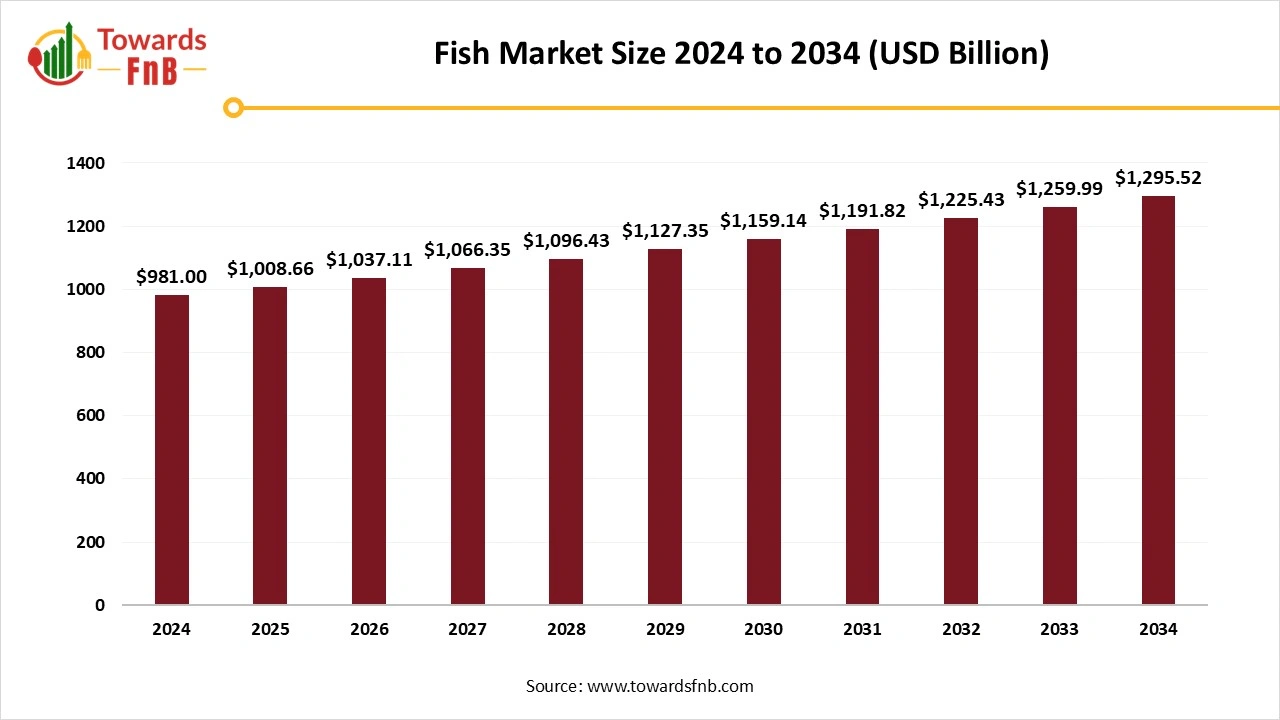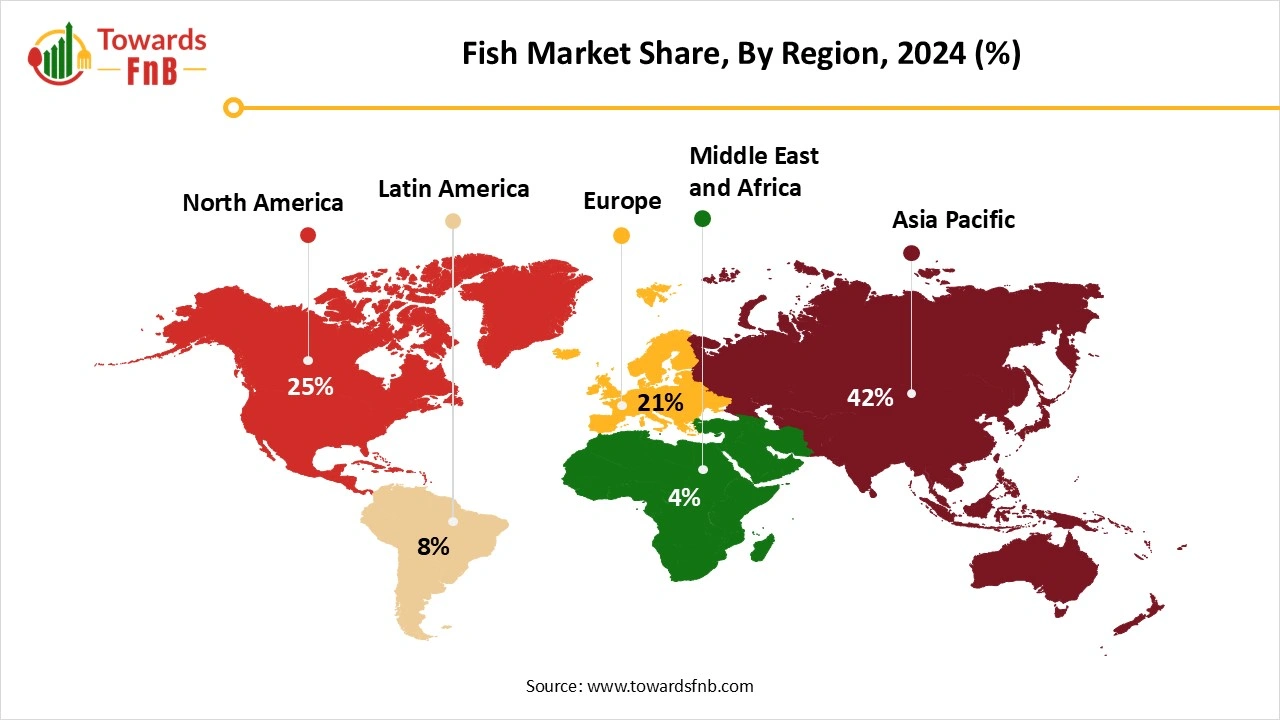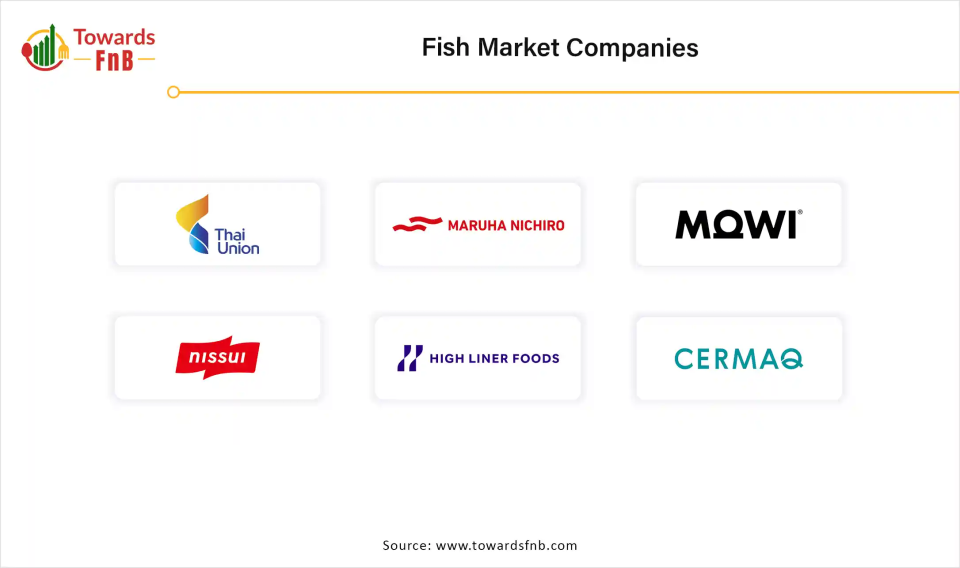December 2025
The global fish market size was reached at USD 981 billion in 2024 and is anticipated to increase from USD 1,008.66 billion in 2025 to an estimated USD 1,295.52 billion by 2034, witnessing a CAGR of 2.82% during the forecast period from 2025 to 2034. The demand for fish is increasing due to rising health awareness, which promotes highly nutritious foods that include protein. Vitamins, fatty acids and many more.

| Study Coverage | Details |
| Growth Rate from 2025 to 2034 | CAGR of 2.82% |
| Market Size in 2025 | USD 1,008.66 Billion |
| Market Size in 2026 | USD 1,037.11 Billion |
| Market Size by 2034 | USD 1,295.52 Billion |
| Largest Market | Asia Pacific |
| Base Year | 2024 |
| Forecast Period | 2025 to 2034 |
| Regions Covered | North America, Europe, Asia-Pacific, Latin America, and Middle East & Africa |
The fish market refers to the global ecosystem of activities related to the capture, aquaculture, processing, distribution, and retailing of fish for human consumption and other purposes (e.g., pet food, pharmaceuticals). It encompasses both wild-caught and farmed (aquaculture) fish and includes fresh, frozen, canned, dried, and processed fish varieties. The market serves a wide range of end users, including household consumers, hotels/restaurants/caterers (HoReCa), and industrial buyers.
The rapid expansion of the food service industry is one of the major drivers that is influencing the growing demand for fish in various restaurants, hotels, fine-dining, cloud kitchens and many more. Fish is one of the highly popular foods in recent diets due to its protein-rich nature, which helps in the growth of the market. The urban areas are one of the highly contributing regions due to its eating out trend. The rising consumer interest is also attracting the majority of the competition from businesses towards innovation for product diversification and innovation in their menus. This is expected to attract the majority of the demand for various products like pre-marinated or frozen fish.
The consumer dietary preferences for seafood are witnessing rapid shifts in recent years due to rising environmental concerns like water pollution, overfishing and many more. Fish farming also includes the use of chemicals and antibiotics, which are demanding an organic shift from consumers. The sustainable shift is demanding a massive shift to minimize the environmental impact and use eco-friendly feed sources that help in maintaining water quality. There are certifications, which are supporting these initiatives:
The rising government and NGO support by providing incentives and financial support is also expected to introduce new farming techniques and fuel innovation in the coming years.
Fish is one of the highly perishable foods that require cold storage infrastructure like refrigerated storage, transport and retail to maintain its quality during the whole process. The fish market may face certain challenges due to the limited facilities that make the whole process costly. The whole process adds up to the rising costs of the overall product due to maintenance and transportation costs. Additionally, some of the regions have stringent quality standards, which can also lead to shipment rejection in certain cases, resulting in a huge loss for the exporters.
What Made Asia Pacific the Dominant Region in the Fish Market?
Asia Pacific marked its dominance by generating the highest revenue share in 2024. The dominance of the segment is attributed to the strong aquaculture industry in countries like India and China. For instance, in 2024, Asia continues to dominate global aquaculture production, with the Asia Pacific region accounting for 75.6% of the global market revenue. The Asian countries also have a strong consumption rate, which also stands as a major factor behind the higher investment rate in cold chain infrastructure. The fish market is expected to maintain its dominance in the region due to the larger coastal population that is based in inland fish farming as a full-time occupation. (Source: ANN-Asia News Network)

China Fish Market Trends
The dominance of China is attributed to the higher production rate of fish and seafood. The government is also highly supporting aquaculture programs that help in adopting sustainable practices and increase the employment rate in its rural areas. The Chinese population is also expected to adopt seafood, like fish, in their diets due to the rising health awareness.
The Middle East and Africa segment is expected to grow at the fastest CAGR during the forecast period of 2025 to 2034. The growth of the segment is attributed to the rising protein demand in urban diets. The fish market is expanding rapidly as it stands as an affordable protein source. The region is expected to witness global investments in aquaculture to reduce its import dependence, which will help in creating multiple business opportunities for the companies.
Egypt Fish Market Trends
The country has an upper hand in the global fish production rate, which also stands in the global top 10 list. This has led to the rising number of aquaculture projects that will help in boosting the fish production rate in the country. The African and Middle East countries have a higher per capita fish consumption, where Egypt stands as a dominant player. The growing government focus on adopting fish farming projects is expected to play a crucial role in attracting more sustainable and affordable products.
What Made Pelagic the Dominant Among the Fish Types in 2024?
The pelagic dish marked its dominance by generating the highest revenue share in 2024. The dominance of the segment is attributed to the higher consumption rate of tuna and mackerel among humans due to their high protein and Omega-3 content. For Instance, India’s tuna export marked an increase of 31.83% in 2023-24, which is leading towards a rising government focus on exploring new tuna sourcing areas. Moreover, the Indian Ocean is the second-largest tuna-producing region in the world, that marks around 21% of the global production rate. Additionally, the catch volume is also higher due to deep-sea fishing, making them a significant contributor. (Source: ias score)
The Freshwater Segment Will Expand at the Fastest CAGR During the Forecast Period of 2025 to 2034.
The growth of the segment is attributed to the rising fish farming in the Asian countries like India, Bangladesh and Vietnam. The demand is primarily driven by the rising focus as an affordable protein source for the middle-class population. Moreover, the fish farming methods are making advancements towards sustainable adoption, which will help it grow more rapidly in the future.
How did the Wild-Caught Fish Become the Dominant Source in the Fish Market?
The wild-caught segment attracted the highest revenue share in 2024. The dominance of the segment is attributed to its traditional method, which accounts for the majority of the fishing from oceans, rivers, lakes and many more. The fish market has been constantly gaining demand due to the availability of a variety of species that are used in food. Additionally, fish farming stands as a full-time occupation in many rural areas, which has led to the rising investments in the food supply chain in various regions. The governments are expected to increase their investments in these infrastructures that will help them boost their economy.
The Aquaculture Segment is Expected to Grow at the Fastest CAGR From 2025 to 2034.
The growth of the segment is attributed to the rising pressure on wildlife, which leads towards the growing aquaculture. The fish market is expected to witness several innovations like genetic selection, alternative and sustainable fish feeds, like plant and insect-based. The segment is expected to maintain its popularity in the coming years as the governments and NGOs are investing towards aquaculture infrastructure. Additionally, the supply chain control is also expected to help in maintaining the safety of the farmed fish.
How was Frozen Fish the Dominant Among the Overall Fish Products in 2024?
The frozen fish segment generated the largest value in 2024. The dominance of the segment is attributed to the longer shelf life of frozen fish, which makes it ideal for commercial use and long-term trades. Moreover, many businesses only rely on bulk purchases due to higher requirements, which helps in the high popularity of frozen fish. Additionally, fish is gaining significant popularity due to the rising number of food service restaurants in urban areas. As a result, many companies are investing in cold chain infrastructure as it is a long-term, cost-effective solution for them.
The Processed Fish Segment is Expected to Grow at the Fastest CAGR During the Forecast Period of 2025 to 2034.
The growth of the segment is attributed to the busy work lifestyles in the urban areas that prefer ready-to-eat or ready-to-cook products. The companies in the food industry are also investing in innovating multiple product lines like fish patties, marinated fillets, fish fingers and many more. The fish market is expected to massively invest in clean-label products to attract a majority of growth from the urban areas. For example, companies are mentioning organic, allergen-free, certified and many others to attract multiple consumers.
What Made Humans the Highest Consumers of Fish Globally in 2024?
Human consumption segment dominated the market in 2024. The dominance of the segment is attributed to the higher consumption rate by the individuals as a straight protein, vitamins and minerals. The fish market is expected to gain more popularity as social media platforms are promoting fish as a nutrient-rich food. The rising tourism industry is also one of the major factors that has been helping in boosting fish consumption in various areas as a part of their culinary tradition. Additionally, there has been constant innovation in manufacturing and consumption, which has led to the constant growth in the number of fish among humans.
The Pharmaceuticals and Nutraceuticals Segment Will Expand at the Fastest CAGR During the Forecast Period of 2025 to 2034.
The use of fish is widely used in various supplements like Omega-3 tablets, fish oils, collagen and gelatin. The fish market will maintain its dominance in the future due to the rising prevalence of various health conditions like CAD, Arthritis, and others that promote fish as a major source in their medications. Additionally, the rising supplement consumption in the urban areas is expected to make the use of fish more popular among the adult population in the future.
How did the Retail Channel Dominate the Distribution of Fish in 2024?
The retail channel marked its dominance by generating the highest revenue share in 2024. The dominance of the segment is attributed to the widespread infrastructure of supermarkets, hypermarkets, and local distribution channels. These channels are considered to be an ideal choice for human consumption due to the availability of various types of products. These distribution channels are investing heavily in various cold chain infrastructure that helps in maintaining the demand through various display and selling strategies. Additionally, the food service industry players have tie-ups with these retail channels due to constant demand.
The Online Retail Segment Will Expand at the Fastest CAGR During the Forecast Period.
The growth of the segment is attributed to the rising consumer preference for convenient food delivery services. The fish market is witnessing a rapid shift due to the expansion of e-grocery platforms like BigBasket, Amazon Fresh, Lucious and many more. The rising smartphone users is expected to attract more investments for premium and niche products in the coming years. The new market players are also investing in digital marketing to expand the reach and popularity of their product lines.
How Was the Frozen Preservation Method for Fish Dominant in 2024?
The frozen fish segment generated the highest revenue share in 2024. The dominance of the segment is attributed to the longer shelf life of the products, which makes them affordable for various uses. The fish market will maintain its demand as international trade is increasing rapidly, which will help the companies to improve their business. Additionally, the retail players also prefer keeping these fish in these methods as it avoids any loss margin. The changing lifestyles are also expected to adopt frozen fish due to its easy storage needs.
The Smoked Segment Will Rise at the Fastest CAGR During the Forecast Period of 2025 to 2034.
The growth of the segment is attributed to the increasing consumer preference for ready-to-eat products. The companies are innovating various product lines to target health-conscious consumers with clean-label products. Smoking technique is expected to gain popularity as the online platforms are investing in providing vacuum-packed fish that are easy to store and consume with minimal cooking requirements.
Maiman
High Liner Foods

By Fish Type
By Source
By Product Type
By Distribution Channel
By End Use
By Preservation Method
By Region
December 2025
December 2025
December 2025
December 2025